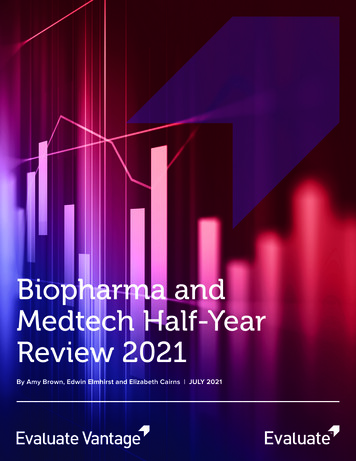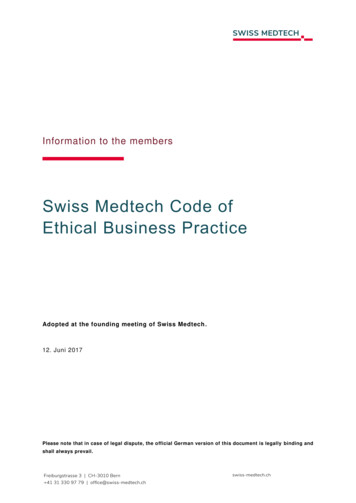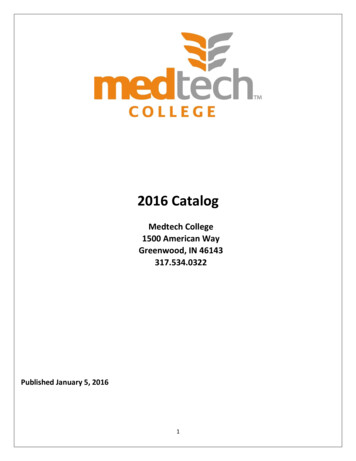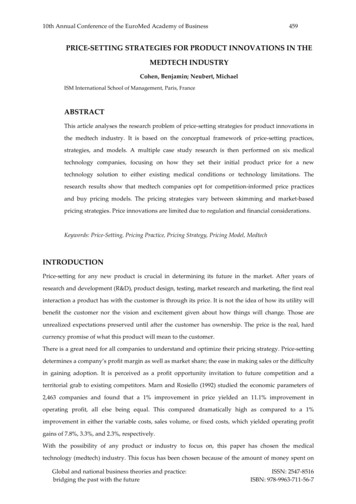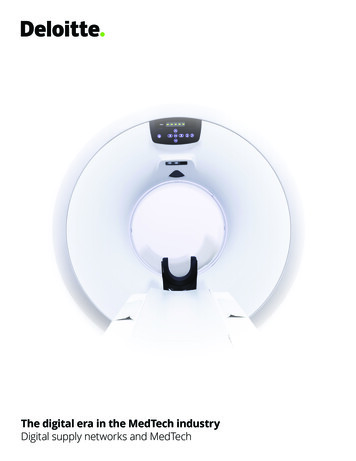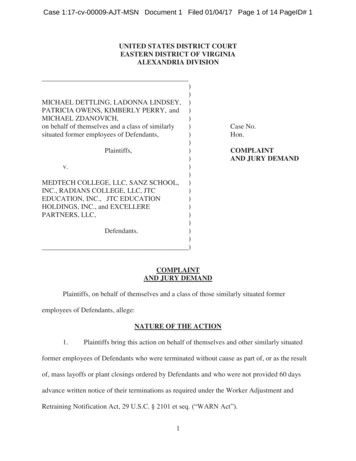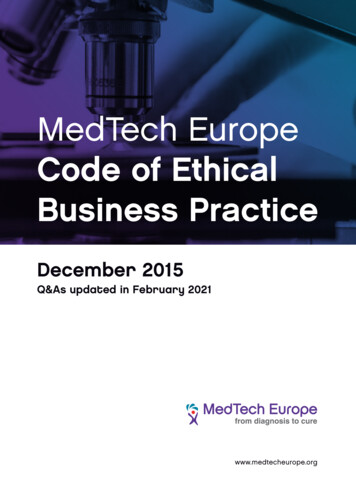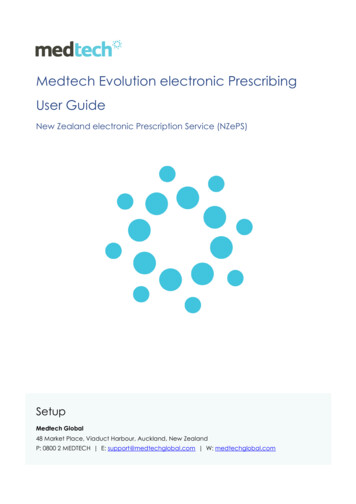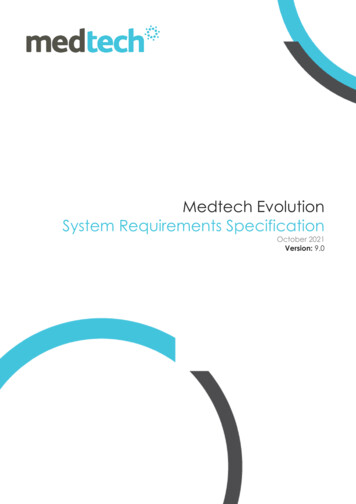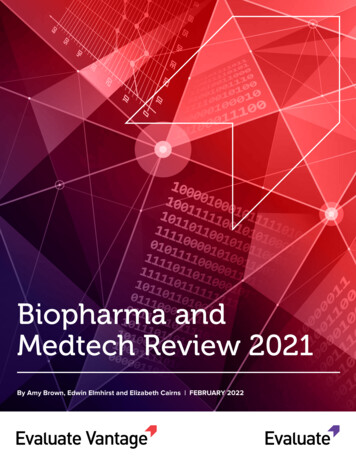
Transcription
Biopharma andMedtech Review 2021By Amy Brown, Edwin Elmhirst and Elizabeth Cairns FEBRUARY 2022
ForewordWelcome to Evaluate Vantage’s 2021 review. This report provides aroundup of our end of year data stories, which dig into the trendsdriving business development decisions and financing deals acrossthe pharmaceutical, biotechnology and medtech sectors.These industries certainly generated mixed signals last year. Biotech indices deteriorated markedly in the USand IPOs slowed, but the venture industry continued to deploy substantial amounts of capital. Developersthat capitalised on the pandemic reaped huge rewards and solid investor support, but many others had towork extra hard to attract attention.Contradictions were on show in the medtech arena too. The markets here were more buoyant than forpharma though, unusually, among the bigger groups those listed in the US had a harder time than those inEurope. Huge amounts were raised by device makers going public, almost entirely in the US – but thesecompanies too had a tricky time once on the market.Indeed it was perhaps a good year to stay private, with venture investors disbursing more cash than everbefore.On the M&A front the pharma sector failed to provide the sort of deals that set the sector alight. Drugdevelopers were still active dealmakers, or course, but seemed to prefer smaller transactions when it cameto buyouts.The opposite was true in medtech, with big acquisitions ticking over nicely but a conspicuous drop in thenumber of smaller deals. In fact, the average price paid for M&A in 2021 was higher than ever, at 1.12bn.At least the FDA remained friendly, with 58 novel therapeutics approved in 2021. Seven of last year’s newarrivals are forecast to become blockbusters within thenext five years, Evaluate Pharma’s consensus data show.But the pandemic is still being felt in the regulatory world.Several high-profile drugs were delayed due to travelrestrictions, while diagnostic device approvals dippedbecause the agency had to prioritise Covid-relatedproducts.Evaluate Vantage will keep monitoring these trends in2022, but for a closer look at what investors and othersare thinking about the coming year, download our freepreview here.For the original articles that make up this Review of 2021report, check out the data section on our website.2Evaluate Vantage Pharma and Medtech Review 2021 Key Takeaways 58 novel therapeutics approved(three-year high) but Covid delayed more 14.2bn raised over 98 IPOs but biotechindices deteriorated significantly in the US Private companies hauled in 28.5bnin 2021 M&A in biopharma didn’t set the worldalight – but medtech did well, with anaverage price at a record 1.12bnCopyright 2022 Evaluate Ltd. All rights reserved.
ContentsBiopharma Review 2021Big beasts drive biopharma valuations higher in 2021 4After a record year, where next for biopharma flotations? 9In 2021 it paid to stay private when the chips were down 12Biotech investors pray for a M&A miracle 14The FDA brushes off the pandemic with a pick-up in novel drug approvals 16Medtech Review 2021A bad year to be an American medtech 18Device makers buy big 22Medtech scores its biggest-ever venture haul 25Medical device groups float – then sink 28Device approval times lengthen 3Evaluate Vantage Pharma and Medtech Review 2021 31Copyright 2022 Evaluate Ltd. All rights reserved.
Biopharma Review 2021Big beasts drive biopharma valuations higher in 2021The biopharma industry saw dramatic divergences in fortunes on the stock market last year. A handful oflarger developers, many propelled by Covid-19 windfalls, enjoyed huge valuation bumps, while the smallerend of the sector witnessed a painful desertion of investor support.Overall, pharma and biotech stocks did manage to gain in valuein 2021, according to Evaluate Vantage’s global overview ofshare price performances. But advances were much harder wonas the year progressed, while the final quarter’s last gasp had alot to do with Pfizer’s massive 90bn market cap bounce.Pharma and biotech stocks didgain value in 2021 – but thoseadvances were hard won.At the start of 2021 Evaluate Vantage started tracking 701 globally-listed, pure-play drug developers,information on which are collected by Evaluate Pharma. These groups added 380bn in market cap over theyear, the chart below shows, thanks to a very strong second quarter; third quarter losses were not recoveredin the final months of the year.The shifting valuation of global drugmakers6k 5,182bn 68bnYE 2020 cohortQ1 2021 323bn- 84bn 72bn 5,562bnQ2 2021Q3 2021Q4 20212021 YTDMarket cap change ( bn)5k4k3k2k1k0Source: Evaluate.4Evaluate Vantage Pharma and Medtech Review 2021 Copyright 2022 Evaluate Ltd. All rights reserved.
Any analysis based on market capitalisation will be heavily influenced by the big beasts of the sector, ofcourse, so the trend above is largely driven by big pharma companies, as the more detailed charts belowshow. These were constructed by splitting the 701-strong universe into four cohorts based on marketcapitalisation at the start of the year; companies remained in the same group throughout the year.The world’s 11 big pharma firms had a very strong end to the year. Only Astrazeneca dipped in value in thefourth quarter, although it should be remembered that this stock hit a record high in November after anincredibly strong run.Pandemic success stories produced gainers elsewhere, with Moderna a stand-out example. A seriouspullback in the fourth quarter knocked more than 50bn from the RNA researcher’s market cap, but thecompany still managed to end the year worth more than 100bn. For context, only 16 drug developers weretrading above that threshold at the end of 2021.Moderna’s deflation had a lot to do with the large cap group’s fourth-quarter decline. So too did the loss ofAlexion, whose takeover by Astrazeneca erased 40bn in market cap from the cohort, making the year-endreverse appear more severe than it really was.Absolute market cap gains and losses, by size bracket300Market cap movement ( bn)60% of large cap group decline due to Alexion sale2001000-100-200Q1 2021Big pharmaQ2 2021Large cap ( 25bn )Q3 2021Mid cap ( 5bn- 25bn)Q4 2021Small cap ( 250m- 5bn)Source: Evaluate.5Evaluate Vantage Pharma and Medtech Review 2021 Copyright 2022 Evaluate Ltd. All rights reserved.
Asian pharma groups also dealt the large caps a hit. Big decliners over the fourth quarter and the yearincluded Chugai, whose questionable ability to replace some of its big sales generators is causing concern.Finally, among the mid and small caps, the real pain began in the second half of 2021, when losses really startto rack up in both absolute and percentage terms. Two-thirds of the stocks in these two groups ended 2021in negative territory.As always, clinical setbacks were responsible for big individual drops, but sentiment towards US biotechstocks deteriorated rapidly as 2021 progressed, causing broader declines.Percentage market cap gains and losses, by size bracket15% market cap movement1050-5-1060% of large cap group decline due to Alexion sale-15Q1 2021Big pharmaQ2 2021Large cap ( 25bn )Q3 2021Mid cap ( 5bn- 25bn)Q4 2021Small cap ( 250m- 5bn)Source: Evaluate.Biopharma’s stock market winners of 2021 revealedCovid’s ability to infect share prices remained intact last year: the pandemic spurred some of the bestindividual performances among biopharma stocks, and was also responsible for several fallers. Indeed, a fewnames appeared on the other side of the leader boards compared with this time last year.For example, the bubble burst for Shin Poong, the South Korean developer that had soared in 2020 onhopes that its repurposed malaria drug might play a big role in the pandemic. On the other hand, the bignames in Covid vaccines were the clear 2021 winners, while Lilly deserves a mention for becoming the bestperforming big pharma stock for the second year in the row.6Evaluate Vantage Pharma and Medtech Review 2021 Copyright 2022 Evaluate Ltd. All rights reserved.
Huge expectations for tirzepatide, a novel diabetes and obesity project, and the Alzheimer’s contenderdonanemab drove Lilly’s valuation to a record high. The group’s market cap has doubled in the past twoyears, a remarkable advance for a company of this size.Novo Nordisk has also had a spectacular run. Its stock also recently hit record highs after doubling in twoyears, thanks to the very successful launch of its new obesity drug, Wegovy. Elsewhere, Biohaven andHorizon’s successful transitions to commercial-stage developers continue to attract investors.Biopharma’s biggest stock market winners in 20212021 shareprice change2021 market capchange ( bn)Market cap atDec 30. 2021 ( rna149%62103Merck KGaA59%42113Novo .0Horizon51%8.324.4Prothena311%1.82.3Bicycle Therapeutics239%1.41.8Anavex Life Sciences221%1.01.3Bellus Health180%0.20.8Bonus Biogroup160%0.10.5Evolus94%0.10.4CompanyBig pharmaLarge cap ( 25bn market cap)Mid cap ( 5-25bn market cap)Small cap ( 250m-5bn market cap)Arising from the nano caps (sub 250m market cap)Source: Evaluate Pharma. Note: companies were assigned these groupings based on year-end 2020 market cap.Among the small caps, Prothena was a beneficiary of progress in Alzheimer’s disease, although it has otherirons in the fire; Anavex also probably benefited from rising expectations of progress in the neurological field.Bicycle operates in the red-hot targeted oncology space, where its work has shown early promise.Finally, nano caps that saw big advances, sufficient for them to join the small caps in 2022’s analysis, includedBellus Health. The company’s stock more than doubled towards the end of 2021 after a successful phase 2btrial revived hopes for the company’s chronic cough project, BLU-5937.As for the fallers, among the big pharma names these single-digit retreats are unlikely to cause long-terminvestors too much concern; however, it is certainly true that all three companies are under pressure toreplenish their late-stage pipelines.7Evaluate Vantage Pharma and Medtech Review 2021 Copyright 2022 Evaluate Ltd. All rights reserved.
The large-cap cohort is dominated by Asian developers, many of which struggled in 2021, outside this topthree. Celltrion was one of 2020’s biggest risers, having also received something of a Covid boost afterdeveloping an antibody therapy, but sentiment turned last year with investors unconvinced about demand forthat product and its wider biosimilar portfolio.Among the smaller developers it is, as always, clinical blow-ups behind the catastrophic declines.Both Allakos and Bridgebio crashed out in the final days of 2021, providing investors with salient remindersof the risks of drug development.Biopharma’s biggest stock market losers in 20212021 shareprice change2021 market capchange ( bn)Market cap atDec 30. 2021 ( bn)Novartis-7%-19196Merck & Co-6%-13194Bristol Myers Squibb1%-2138Jiangsu 93%-6.80.5Bridgebio-77%-6.32.5Shin Poong-74%-4.31.4Oncopeptides-95%-1.20.1Sigilon Therapeutics-94%-1.30.1Forte Biosciences-94%-0.40.0CompanyBig pharmaLarge cap ( 25bn market cap)Mid cap ( 5-25bn market cap)AllakosSmall cap ( 250m-5bn market cap)Source: Evaluate Pharma. Note: companies were assigned these groupings based on year-end 2020 market cap.This analysis was constructed by tracking pure-play drug developers, listed globally, with a market cap in excess of 250m at the start of 2021.Companies were split into four cohorts and remained in the same group throughout the year. The 11 companies that comprise the big pharma groupare: Johnson & Johnson, Roche, Pfizer, Eli Lilly, Abbvie, Novartis, Merck & Co, Astrazeneca, Bristol Myers Squibb, Sanofi and Glaxosmithkline.More detailed analyses of these data and Evaluate Vantage’s widercoverage of share price performances can be found on our website here.8Evaluate Vantage Pharma and Medtech Review 2021 Copyright 2022 Evaluate Ltd. All rights reserved.
After a record year, where next for biopharma flotations?The pace of biopharma IPOs might have slowed over the course of 2021 but on many measures the year wasunprecedented. Those record-setting days are over, however, with many predicting further retrenchment in2022.The depth of any slowdown is the big unknown, and the signs so far are mixed. Impressively, four developersfloated in the opening days of the year, three of which managed to upsize their deals, while a couple moregroups are sitting in the queue. The other side to this story is weak demand for newly floated biotech stocks,and a couple of recently pulled IPOs.This suggests that while the window of opportunity is narrowing, it has not completely shut. Consideringthe parlous state of US biotech stocks, which have endured a 10-month bear market that shows no sign ofbottoming out, this is in many ways remarkable.An explanation can be found in well-stocked venture and crossover funds, which are able support portfoliocompanies throughout, and after, the IPO process. But with conditions getting tougher, private groups thatmanage to get away successfully this year will surely represent the cream of the venture-backed crop.Tracking demand via bumps and haircutsAverage premium/discount10%0%-10%2QQ1201720Q 17320Q 17420Q 17120Q 18220Q 18320Q 18420Q 18120Q 19220Q 19320Q 19420Q 19120Q 20220Q 20320Q 204202Q 0120Q 21220Q 21320Q 2142021-20%Average premium/discount of float price over initially proposed price rangeSource: Evaluate.9Evaluate Vantage Pharma and Medtech Review 2021 Copyright 2022 Evaluate Ltd. All rights reserved.
The prospects will be much dimmer for developers that do notfit into that category, and indeed there is much evidence tosuggest this is already the case. Signs of weakening of demandstarted to emerge in mid-2021 when, as the graph abovesuggests, it became harder for bankers to extract any uplift to aninitially proposed valuation.Did the flood of early stageand, in some cases, low-qualitynew issues take the steam outof the biotech market?It is also worth noting that almost 80% of last year’s new issueswere trading below their float price by the end of 2021. Some have already seen huge declines, with 35%losing more than half of their value. It is also true, however, that broader market conditions have been terribleand small caps have borne the brunt of this, as the previous section discussed.None of this will make for comforting reading for those companies still hoping to test the public marketwaters. But it is also true that the final quarter of 2021 was far from a disaster, generating respectable statswhen looking over the past five years.This chart below illustrates the sheer size of 2021. On almost every metric the year set a new record, from the 14.2bn raised over 98 IPOs, to the number of deals that banked more than 100m: 62, according to EvaluatePharma.40 4.5bn30 3bn20 1.5bn10 0bn0Q12Q 01722Q 01732Q 017420Q 1712Q 01822Q 01832Q 018420Q 1812Q 01922Q 01932Q 01942Q 01912Q 02022Q 02032Q 020420Q 2012Q 02122Q 02132Q 02142021 6bnIPO countAmount raisedBiotech IPOs by quarter on Western exchangesAmount raisedCountSource: Evaluate.10 Evaluate Vantage Pharma and Medtech Review 2021 Copyright 2022 Evaluate Ltd. All rights reserved.
This is a performance unlikely to be matched in 2022, though that might not be a bad thing. Many blame theflood of early-stage and, in some cases, low-quality new issues for taking the steam out of the biotech marketmore generally. Even some venture capitalists will concede that a slowdown would not be all bad.Biopharma watchers will be keen to find out whether this year’s early rush continues at pace, or quicklyfizzles out.More detailed analyses of these data and Evaluate Vantage’s widercoverage of IPO trends can be found on our website here.11 Evaluate Vantage Pharma and Medtech Review 2021 Copyright 2022 Evaluate Ltd. All rights reserved.
In 2021 it paid to stay private when the chips were downFor biotech in 2021 it paid to be private. While waning public investor sentiment made the year a minordisaster for listed companies, closely held groups enjoyed their most successful 12 months ever, with securedventure capital eclipsing 2020’s then record-breaking total by 26%.True, the data are not wholly positive: 2021 was driven by a massive first quarter, after which VC financing fell,and the absolute number of deals continued the broad downward trend of the past few years. As such it wasa handful of gigantic rounds, including a 700m series C by a Chinese group, that secured 2021’s place inthe record books.But it says something that this round, raised by Abogen Bioscienceslargely to finance development of a thermostable mRNA Covid-19vaccine, came in an otherwise lacklustre third quarter. This periodoverall was on a par with 2020’s third quarter, and its 6.0bn of VCfinancing was barely half that seen in the first three months of 2021.Private companies hauled ina whopping 28.5bn of cash.200 9bn150 6bn100 3bn50 0bn0Q12Q 01722Q 01732Q 017420Q 1712Q 01822Q 01832Q 018420Q 1812Q 01922Q 01932Q 01942Q 01912Q 02022Q 02032Q 020420Q 2012Q 02122Q 02132Q 02142021 12bnNumber of roundsCombined InvestmentQuarterly biopharma VC roundsOther rounds 50m- 100m rounds 100m roundsCountSource: Evaluate.Over the year private companies hauled in 28.5bn of cash, with Abogen accounting for 1bn of this annualtotal. Its 700m series C, led by seven investors including Singapore’s state investment firm TemasekHoldings, was the biggest single VC raise of the year; it was followed in the fourth quarter by a series “C ”,which amounted to another 300m.Other notable fourth-quarter VC rounds included a 500m series A by Neumora, a US biotech focusing onneuroscience, whose raise was the joint third-biggest of 2021.12 Evaluate Vantage Pharma and Medtech Review 2021 Copyright 2022 Evaluate Ltd. All rights reserved.
That said, 2021’s VC total will most likely be remembered for a record-breaking first quarter, which includedraises by the cell therapy group Elevatebio and by EQRX, a company seeking to shake up oncology drug pricing.Annual biopharma venture investmentsYearInvestment( bn)FinancingcountAvg per financing( m)No of rounds 50mNo of rounds 957324.57316Source: Evaluate Pharma.However much the public markets struggled in 2021, the hope emerging from the year’s VC data is thatmany financiers see a turnaround sooner rather than later. The possibility of public listing remains key tounderpinning a company’s valuation when it is seeking private funds.EQRX is a case in point. Though it is by no means clear whether competing on price in oncology is a realisticstrategy, the group is now going public, albeit by means of a Spac, in a 1.8bn deal.2021’s biggest biotech venture roundsCompanyCountryInvestment ( m)Financing roundThe top five of Q4 2021.NeumoraUS500Series ASotioCzech Republic315.9Series undisclosedAbogen BiosciencesChina300Series C AcelyrinUS250Series BCardurion PharmaUS219.7Series undisclosed.and the best of 2021 overallAbogen BiosciencesChina700Series CElevatebioUS525Series CEQRXUS500Series BNeumoraUS500Series ABiospliceUS438Series ASource: Evaluate Pharma.More detailed analyses of these data and Evaluate Vantage’s widercoverage of venture financing trends can be found on our website here.13 Evaluate Vantage Pharma and Medtech Review 2021 Copyright 2022 Evaluate Ltd. All rights reserved.
Biotech investors pray for a M&A miracleLast year failed to deliver much fizz on the M&A front, though the final months of the year raised hopes fora pick-up in activity. Unfortunately, the week of the JP Morgan Healthcare conference, a favourite time forbiopharma companies to unveil their latest moves, was bereft of big-ticket buyouts.True, a string of smaller transactions did emerge, and few would dispute that the sector remains an activedeal-making space. But with US biotech stocks languishing investors are desperate for sentiment to improve.A clear signal that the large end of the sector is putting serous money to work could help trigger an upturn.The problem is that large developers seem to prefer small bolt-ons and licensing deals, a trend that EY alsohighlighted in its annual review of biopharma spending. According to Evaluate Pharma the two biggestcompany takeouts in 2021 barely breached 10bn. In this analysis, Evaluate Vantage considers only dealsbetween pure-play drugmakers, and sorts the data by announcement data, rather than when transactionsofficially close.Biggest biopharma M&A deals announced in 2021AcquirerTargetStatusValueCSLVifor Pharma GroupOpen 11.7bnMerck & CoAcceleron PharmaClosed 11.5bnJazzGW PharmaceuticalsClosed 7.2bnPfizerArena PharmaceuticalsOpen 6.7bnNovo NordiskDicerna PharmaceuticalsClosed 3.3bnSource: Evaluate Pharma.The sector’s last mega-buyout was Astrazeneca’s 39bn swoop on Alexion, which was announced inDecember 2020. Deals of that size are infrequent, of course, but based on timing alone biopharma isprobably due another big one.What this might be is the burning question. Biogen was recently added to the list of motivated buyers, aftercomments made by the company’s chief executive. Shares in Aurinia, Biohaven and Amylyx all rose afterbeing named as potential targets by Stat.Aurinia has long been considered a target, with both Bristol Myers Squibb and Glaxosmithkline reported tobe interested, though no buyout has appeared. And, with a market cap of 2.4bn, its acquisition would hardlyset the sector on fire.With Novartis sitting on a windfall from the sale of its Roche stake, Pfizer rich on Covid cash and plenty ofothers well stocked, biopharma is not bereft of firepower. Going by the state of the markets it might soon notbe short of sellers.14 Evaluate Vantage Pharma and Medtech Review 2021 Copyright 2022 Evaluate Ltd. All rights reserved.
The closely watched exchange-traded fund the XBI fell below 100 in the opening days of 2022 for thefirst time in 18 months. Demand for US biotech stocks is as poor as many can remember for some time. Itmight take a string of Aurinia-type deals, and possible a couple of Alexion’s size, before this tanker is turnedaround.9675725048252400Q12Q 01722Q 01732Q 017420Q 1712Q 01822Q 01832Q 018420Q 1812Q 01922Q 01932Q 01942Q 01912Q 02022Q 02032Q 020420Q 2012Q 02122Q 02132Q 02142021100Deal countValues ( bn)Quarterly M&A dealsOther deal types combined valueMega-mergers ( 30bn ) combined valueCompany takeouts combined valueDeal CountSource: Evaluate.More detailed analyses of these data and Evaluate Vantage’s widercoverage of M&A trends can be found on our website here.15 Evaluate Vantage Pharma and Medtech Review 2021 Copyright 2022 Evaluate Ltd. All rights reserved.
The FDA brushes off the pandemic with a pick-up innovel drug approvalsThe US drugs regulator approved 58 novel drugs last year, the highest number for three years and wellabove the 10-year average of 48. With travel limitations blamed for decision delays in a number of cases,Novartis’s Leqvio and UCB’s Bimzelx included, this uptick could presumably have been steeper undermore normal conditions.The only Covid product included in this count is Biontech andPfizer’s Comirnaty; all the other pandemic-related projects areon the market under emergency use authorisations, ratherthan full approvals.The US drugs regulator approved58 novel drugs last year – wellabove the 10-year average of 48.Comirnaty is almost certainly going to become last year’s biggest approval commercially speaking, though by2026 annual sales are forecast to have dipped substantially.Ten years of FDA approvals70Approval count605040302020122014201620182020FDA approval countSource: FDA.16 Evaluate Vantage Pharma and Medtech Review 2021 Copyright 2022 Evaluate Ltd. All rights reserved.
This time last year Biogen’s Aduhelm was predicted to be the class of 2021’s biggest seller, according tofifth year sales as predicted by sellside analysts. But should January’s punitive US coverage decision holdconsensus is likely to drop to close to zero.That still leaves plenty of potential future blockbusters that arrived on the market in 2021, according toEvaluate Pharma’s consensus in the table below. It is worth remembering that several of these projects needto win expanded labels, or carve out share in highly competitive therapy areas, to reach these lofty levels.Potential blockbuster tableProductCompanyDescription2026e US salesLeqvioNovartissiRNA-based anti-PCSK9 for high cholesterol; approvedin heterozygous familial hypercholesterolaemia andatherosclerotic cardiovascular disease. 1.7bnAbecmaBristol MyersSquibb/BluebirdAnti-BCMA Car-T cell therapy; approved for B-cell andfollicular lymphomas 1.4bnComirnatyPfizerCovid-19 vaccine 1.4bnTezspireAmgenAnti-TSLP MAb; approved in severe asthma 1.2bnVyvgartArgenxAnti-FcRn MAb for IgG-mediated autoimmune diseases;approved in myasthenia gravis 1.2bnLumakrasAmgenKras G12C inhibitor; approved in non-small cell lungcancer 1.2bnLupkynisAuriniaCalcineurin inhibitor; approved in lupus nephritis 1.1bnSource: Evaluate Pharma.More detailed analyses of these data and Evaluate Vantage’s widercoverage of regulatory trends can be found on our website here.17 Evaluate Vantage Pharma and Medtech Review 2021 Copyright 2022 Evaluate Ltd. All rights reserved.
Medtech Review 2021A bad year to be an American medtechWith better availability of rapid Covid tests, often free of charge, and more centralised healthcare systemsoverseeing vaccination efforts, European countries have arguably been better able to manage the effectsof the pandemic than the US. Perhaps this is why nearly all the big-cap groups that enjoyed the biggestincreases in valuation last year were listed in Europe, and nearly all the fallers listed in New York.Better investor confidence in Europe seems the likeliest explanation for the Swedish group Getinge havingmore than doubled in value while Teleflex, a US company that plays in similar hospital supply and cardiologyareas, experienced a 20% share price fall.The medical device indices back this interpretation, the Stoxx Europe 600 health care index havingoutpaced the Dow Jones US medical equipment basket. That said, these do not track precisely with bigcap companies; the Dow Jones index, for example, tracks 65 US-listed groups with a median market cap of 4.3bn.IndicesStock index% change in 2021Stoxx Europe 600 health care23%Dow Jones US medical equipment index21%S&P composite 1500 healthcare equipment & supplies18%Source: Evaluate Medtech.18 Evaluate Vantage Pharma and Medtech Review 2021 Copyright 2022 Evaluate Ltd. All rights reserved.
As the Omicron variant threatens to overwhelm hospitals despite its apparently milder symptoms, a hospitalequipment manufacturer rules the roost. Sweden’s Getinge, which sells acute care products used in the ICU,as well as cardiac, vascular and pulmonary devices, more than doubled in value across last year.The remaining risers are in disparate sectors – dental, cardiovascular, diagnostics and hearing – but all butPenumbra are hosted on European exchanges.The converse is seen with the fallers. Only one, Philips, has a European berth. This group had a disastrousyear, and arguably did well to get away with a loss of just a quarter of its value.Large cap ( 10bn ) medtech companies: top risers and fallers in 2021Share price12-mth changeMarket cap atDec 31 ( bn)Market cap 12-mthchange ( bn)Top 5 risersGetinge (SKr)106%11.55.9Straumann (SFr)88%33.515.5Penumbra ( )64%10.74.4Siemens Healthineers ( )59%85.330.3Sonova (SFr)56%24.28.3Teladoc Health ( )(54%)14.7(14.3)Exact Sciences ( )(41%)13.4(6.5)Philips ( )(25%)32.9(13.9)Guardant Health ( )(22%)10.2(2.7)Teleflex ( )(20%)15.4(3.8)Top 5 fallersSource: Evaluate Medtech.19 Evaluate Vantage Pharma and Medtech Review 2021 Copyright 2022 Evaluate Ltd. All rights reserved.
Other fallers are US-based and have perhaps suffered excessively harsh punishment. The digital healthbehemoth Teladoc led the risers at the end of 2020 as locked-down users flocked to its virtual healthcaretech. As restrictions eased in 2021 it has been unable to maintain the same growth, and skittish investorsdeserted.The mid-caps – those whose market cap sits beneath 10bn but above 2.5bn – were led by diagnosticsgroup Fulgent Genetics, which nearly doubled in value. Fulgent’s 93% growth came partly as a result of itsCovid tests; its PCR assay was authorised in the US in May 2020 and the cash this generated enabled thecompany to triple in size across 2020.Other significant risers and fallers in 2021 (ranked on market cap)Share price12-mth changeMarket cap atDec 31 ( bn)Market cap 12-mthchange ( bn)Top 5 risersTandem Diabetes Care ( )57%9.63.7Fulgent Genetics ( )93%3.01.7Ypsomed (SFr)28%2.60.5Senseonics ( )207%1.21.0Iradimed ( )103%0.60.3Novocure ( )(57%)7.8(9.8)Invitae ( )(63%)3.5(3.9)Top 5 fallersHaemonetics ( )(55%)2.7(3.3)Cardiovascular Systems ( )(57%)0.8(1.0)Tactile Systems Technology ( )(58%)0.4(0.5)Source: Evaluate Medtech.20 Evaluate Vantage Pharma and Medtech Review 2021 Copyright 2022 Evaluate Ltd. All rights reserved.
Insulin pump developers did well, with Tandem and Ypsomed among the five biggest mid-cap risers. Theformer rose steadily across the year as sales of its insulin pumps picked up as lockdowns were lifted. Italso benefited late in the year from the ongoing quality control nightmare at Medtronic’s diabetes pumpmanufacturing site.Another diabetes player, Senseonics, also rose significantly. The company makes Eversense, a tinyblood glucose monitor that is implanted in a patient’s upper arm and works for either three or six months.Senseonics had a rotten 2019 and a lacklustre 2020, but came roaring back in early 2021 as a distri
The opposite was true in medtech, with big acquisitions ticking over nicely but a conspicuous drop in the number of smaller deals. In fact, the average price paid for M&A in 2021 was higher than ever, at 1.12bn. At least the FDA remained friendly, with 58 novel therapeutics approved in 2021. Seven of last year's new
